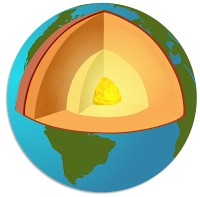Tuesday, March 19, 2013
Earth’s interior affects long-term sea-level and climate change
Joshua S. Hill in PlanetSave: Climate change deniers are often want to pronounce the current trends in our climate as being part of a larger cycle of warming. Despite the overwhelming lack of evidence for such a claim, it is always important to look at climate cycles to see where and how they might play a part. New research published in the journal Eos looks at the long-term cyclical activity of the world below our planet’s surface.
Ancient rises in sea levels and global warming are partially attributable to cyclical activity below the earth’s surface, researchers from NYU and Ottawa’s Carleton University have concluded in an analysis of geological studies.
Article author’s Michael Rampino from New York University and Andreas Prokoph from Carleton University found that cyclical activity below the Earth’s surface does indeed play a part in rising sea levels and global warming.
Rampino and Prokoph’s analysis looked at long-term fluctuations in the global climate, the diversity of marine organisms, and sea level changes, in an attempt to identify a unifying cause.
Recent studies into what goes on beneath our planet’s surface have found that the upwelling of mantle plumes — the rising up of heated rocks from the mantle that eventually reach the surface — have a noticeable impact on the eruption of large igneous provinces — known as LIPs — which are basically large masses of rocks that have formed from congealed lava….
Diagram of the earth's layers by Anthonydavis74, Wikimedia Commons, under the Creative Commons Attribution-ShareAlike 3.0 license
Ancient rises in sea levels and global warming are partially attributable to cyclical activity below the earth’s surface, researchers from NYU and Ottawa’s Carleton University have concluded in an analysis of geological studies.
Article author’s Michael Rampino from New York University and Andreas Prokoph from Carleton University found that cyclical activity below the Earth’s surface does indeed play a part in rising sea levels and global warming.
Rampino and Prokoph’s analysis looked at long-term fluctuations in the global climate, the diversity of marine organisms, and sea level changes, in an attempt to identify a unifying cause.
Recent studies into what goes on beneath our planet’s surface have found that the upwelling of mantle plumes — the rising up of heated rocks from the mantle that eventually reach the surface — have a noticeable impact on the eruption of large igneous provinces — known as LIPs — which are basically large masses of rocks that have formed from congealed lava….
Diagram of the earth's layers by Anthonydavis74, Wikimedia Commons, under the Creative Commons Attribution-ShareAlike 3.0 license
Labels:
geology,
sea level rise
Subscribe to:
Post Comments (Atom)




1 comment:
This study does not fit with the theory that CO2 is the devil. It is blaspheme and must be silenced.
klem
Post a Comment